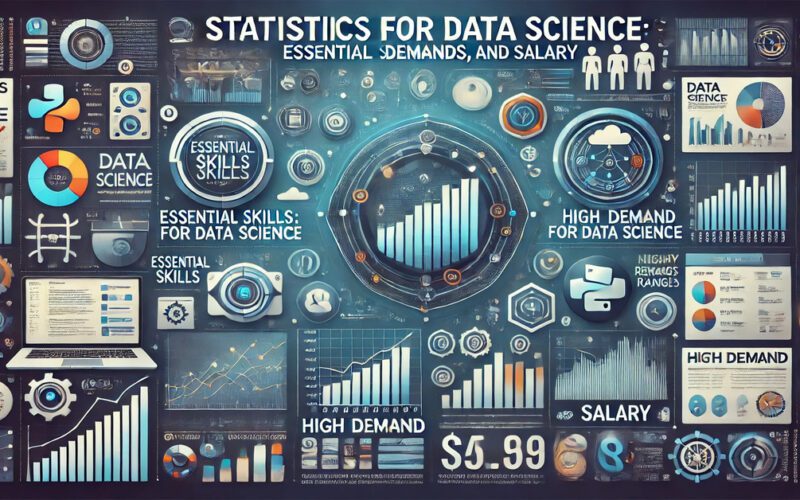Summary: The blog discusses the importance of statistics in Data Science, highlighting essential skills like descriptive and inferential statistics. It emphasises the growing demand for these skills across industries and the lucrative career opportunities for proficient Data Scientists.
Introduction
Statistics for Data Science is a cornerstone skill, providing the analytical foundation for accurate data interpretation and decision-making. By leveraging statistical methods, Data Scientists can uncover trends, test hypotheses, and validate insights, all essential for making informed, data-driven choices.
Statistical skills allow professionals to extract meaning from complex datasets, which support everything from predictive modelling to business intelligence. This article explores the essential statistical skills required for Data Science, examines the demand for these skills across industries, and outlines current salary expectations for roles emphasising statistics in Data Science.
Key Takeaways
- Mastering descriptive and inferential statistics is crucial for Data Analysis.
- The need for statistical expertise is rapidly increasing across various sectors.
- Data Scientists with solid statistical skills enjoy lucrative job opportunities.
- Statistics enhances business decision-making through data-driven insights.
- Effective statistical analysis requires proficiency in Python, R, and SQL.
Why Statistics is Crucial in Data Science
Statistics is at the heart of Data Science, providing essential tools and methods for understanding and working with data. With the global Data Science platform market valued at USD 103.93 billion in 2023 and expected to soar to USD 776.86 billion by 2032, the importance of statistics has never been more evident.
This growth, at a CAGR of 24.7%, underscores the increasing demand for statistical expertise to derive meaningful insights from vast datasets across industries.
Statistics equips Data Scientists with the ability to make sense of complex data. Statistical methods provide a structured approach to handling information, from summarising data patterns to making inferences.
Core statistical skills, including understanding distributions, probability, and sampling, form the backbone of Data Analysis and help avoid misleading conclusions. For Data Scientists, these skills are vital for generating reliable insights that drive informed decision-making.
Key Applications
Statistics plays a pivotal role in both analysing and visualising data. Descriptive statistics help summarise and organise raw data, making it easier to interpret. Inferential statistics allows Data Scientists to make predictions and draw conclusions from sample data.
Through statistical visualisation techniques, such as histograms, scatter plots, and probability distributions, data professionals can effectively communicate findings, uncover trends, and support strategic planning.
Examples
Statistics is essential in Machine Learning, where it supports algorithms in analysing patterns, handling uncertainty, and improving accuracy. Techniques like regression analysis and hypothesis testing enable predictive modelling, a core function in customer segmentation and fraud detection applications.
In business intelligence, statistics help organisations track key performance indicators, understand consumer behaviour, and forecast market trends, ultimately guiding strategic decisions.
Essential Statistical Skills for Data Science
Mastering core areas of statistics can significantly enhance a Data Scientist’s ability to generate actionable insights. Below are some of the most critical statistical skills for Data Science professionals, along with their importance and applications.
Descriptive Statistics
Descriptive statistics summarise a dataset’s basic features, offering a quick overview of its structure and distribution. These techniques provide a snapshot of data’s central tendencies, spread, and overall shape, enabling Data Scientists to make informed decisions based on trends and patterns.
Descriptive statistics are the first step in Data Analysis, which sets the foundation for more in-depth analysis and modelling.
Measures of Central Tendency
Central tendency metrics—mean, median, and mode—help identify the “centre” of a data distribution. For instance, the mean (average) gives an overall sense of the data, while the median and mode help detect skewness or data peaks. By analysing central tendency, Data Scientists can quickly summarise large datasets, setting the stage for deeper analysis.
Measures of Variability
Variability measures, such as standard deviation, variance, and range, show how much data points diverge from the central tendency. A high standard deviation indicates data spread far from the mean, while a low one signals data close to the mean. These metrics are essential for evaluating data consistency and detecting outliers.
Data Distributions
Understanding data distribution patterns, like normal, binomial, or skewed distributions, allows Data Scientists to choose appropriate statistical tests and modelling techniques. For example, knowing whether data follows a normal distribution is vital in selecting valid statistical methods for further analysis.
Inferential Statistics
Inferential statistics go beyond simple data description, allowing Data Scientists to make predictions and draw conclusions about a larger population from sample data. These techniques are essential for validating findings, comparing groups, and making evidence-based decisions, which is invaluable for organisations relying on data-driven strategies.
Hypothesis Testing
Hypothesis testing helps evaluate whether an observed effect in sample data is likely genuine or due to chance. Data Scientists can set up null and alternative hypotheses to test assumptions supporting decisions on launching a new product or optimising a business process.
Confidence Intervals
It quantifies the uncertainty around sample estimates, providing a range within which the population parameter likely lies. For example, a 95% confidence interval for average sales suggests that if the sampling was repeated, the population mean would fall within this interval 95% of the time.
p-Values
The p-value indicates the probability of observing results as extreme as those in the sample, assuming the null hypothesis is true. Data Scientists use p-values to assess statistical significance and decide whether findings are robust or may have occurred by chance.
Probability Theory
Probability theory is essential for understanding data uncertainty and making predictions. In Data Science, probability concepts allow practitioners to estimate the likelihood of future events, interpret data patterns, and confidently support decision-making. Probability theory is widely used in predictive analytics, risk assessment, and model evaluation.
Bayes’ Theorem
Bayes’ theorem is key to updating probabilities based on new information, central to applications like spam filtering and recommendation engines. By incorporating prior knowledge, Data Scientists can enhance predictions and refine model accuracy.
Probability Distributions
Probability distributions, such as the normal, binomial, and Poisson distributions, are mathematical functions that describe the likelihood of different outcomes. Understanding these distributions enables Data Scientists to model real-world phenomena accurately, such as forecasting demand or estimating customer behaviour patterns.
Regression Analysis
This is a powerful statistical tool for understanding relationships between variables, which is crucial for predictive modelling. It enables Data Scientists to estimate the impact of one variable on another, providing insights into trends, patterns, and future projections. Regression models form the core of many Machine Learning and Predictive Algorithms.
Linear Regression
It models the relationship between a dependent variable and one or more independent variables by fitting a straight line to the data. It is widely used in scenarios like sales forecasting, where continuous output prediction is needed.
Logistic Regression
Logistic regression predicts binary outcomes (e.g., yes/no, 0/1) by analysing the probability of a specific event occurring. Data Scientists apply logistic regression in fields such as fraud detection and customer churn analysis, where predictions about categorical outcomes are essential.
Statistical Modelling and Hypothesis Testing
This method involves creating mathematical representations of data relationships to understand patterns, test theories, and make predictions. Hypothesis testing within these models helps Data Scientists determine the validity of observed patterns, making statistical modelling an essential aspect of evidence-based decision-making in Data Science.
ANOVA (Analysis of Variance)
It compares means across multiple groups to identify significant differences. It is commonly used in A/B testing scenarios to assess different versions of a product or feature.
Chi-Square Tests
It evaluates relationships between categorical variables. For example, Data Scientists use chi-square tests in retail to study customer preferences by comparing frequencies across different categories.
Statistical Models
Beyond tests, statistical models predict outcomes and uncover patterns. These models, like time series analysis for trend forecasting, are instrumental in building data-driven decision frameworks.
Data Sampling and Experimental Design
Data sampling and experimental design are critical for obtaining reliable, representative data that accurately reflects larger populations. By selecting appropriate sampling methods and designing well-structured experiments, Data Scientists can ensure the validity of their insights and avoid biases that could impact business decisions.
Data Sampling
Sampling allows Data Scientists to work with manageable data subsets while maintaining representativeness. Techniques like random sampling help avoid bias, ensuring that insights can be generalised to the broader population.
Randomisation and Experiment Design
Randomisation reduces bias, ensuring valid and robust results. Experiment design, particularly in controlled A/B testing, enables Data Scientists to test hypotheses under consistent conditions, leading to trustworthy and actionable insights.
In-Demand Statistical Tools and Technologies
Statistical tools and technologies are critical in Data Science, empowering professionals to analyse data, make predictions, and support business decisions. Mastery of these tools enhances efficiency, accuracy, and versatility, making them indispensable for modern Data Scientists. Here’s an overview of the top tools and technologies in high demand for statistical analysis in Data Science:
Python and R for Statistical Analysis
Python and R are the go-to languages for Data Science, each offering powerful libraries for statistical analysis. Python’s libraries, like Pandas, SciPy, and StatsModels, enable easy data manipulation and analysis. At the same time, R is well-known for its rich statistical packages, making it ideal for complex Data Analysis and visualisation.
SQL for Data Extraction
SQL remains essential for retrieving and manipulating large datasets from databases. It allows Data Scientists to efficiently query, filter, and aggregate data, forming the basis for statistical analysis and modelling.
Excel for Quick Statistical Analysis
Excel’s intuitive interface makes it widely used for quick calculations, descriptive statistics, and exploratory analysis. Its pivot tables, charts, and add-ons (such as Analysis ToolPak) make it convenient for simple statistical tasks.
Specialised Statistical Software (SAS, SPSS, STATA)
Tools like SAS, SPSS, and STATA provide robust options for advanced, industry-specific applications. These programs are particularly favoured in healthcare, finance, and social sciences, where complex statistical procedures and compliance with regulatory standards are essential.
Learning these tools allows Data Scientists to tackle varied analytical challenges, enhancing their ability to draw meaningful insights from data.
Demand for Statistical Skills in Data Science
The demand for statistical skills in Data Science has surged as companies increasingly rely on data to make informed decisions and gain a competitive edge. Data Scientists with solid statistical skills are highly sought after across industries, driving rapid growth in employment opportunities.
The employment of Data Scientists and statisticians is projected to grow by 36 percent from 2023 to 2033, significantly faster than the average growth rate for all occupations.
Current Market Trends for Statisticians and Data Scientists
In today’s data-driven world, statisticians and Data Scientists are critical in extracting valuable insights from vast datasets. Companies invest in Data Science teams to improve decision-making, optimise operations, and enhance customer experiences.
This demand has spiked as businesses recognise the value of data in forecasting, risk management, and innovation. Organisations are now focused on recruiting professionals with a solid grasp of statistical methods to handle complex data challenges and many are turning to Cloud recruiting software to streamline and enhance this process.
Statistical analysis enables Data Scientists to uncover trends and patterns, assess probabilities, and validate findings—essential skills in industries aiming to harness the power of big data. This trend is reflected in tech companies and traditional sectors looking to digitise and innovate through Data Science.
Industries Actively Seeking Statistical Expertise
Several industries have recognised the immense value of statistical expertise and are actively hiring professionals who can make data actionable. These industries value statisticians and Data Scientists’ ability to apply statistical techniques that improve decision-making and increase efficiency.
- In finance, statistics help assess credit risks, analyse market trends, and develop investment strategies.
- The healthcare industry relies on statistical models to improve patient outcomes, conduct clinical trials, and predict disease outbreaks.
- In technology, companies use statistics to enhance algorithms, personalise user experiences, and improve product performance.
- Retail businesses also depend on statistical analysis to optimise inventory, forecast demand, and understand consumer behaviour.
Skills That Enhance Job Marketability
Data Scientists who combine statistical expertise with complementary skills are even more competitive in the job market. Data visualisation is a key skill that enables data professionals to communicate complex insights clearly and persuasively. Proficiency in visualisation tools like Tableau or Power BI makes data more accessible to stakeholders and aids in faster decision-making.
Additionally, understanding Machine Learning basics allows Data Scientists to build predictive models beyond traditional statistical methods. Skills in Machine Learning tools, such as scikit-learn or TensorFlow, broaden a Data Scientist’s capabilities, opening doors to more specialised roles.
Overall, statistical skills paired with visualisation and Machine Learning knowledge can greatly enhance job marketability, making Data Scientists valuable assets across various industries.
Salary Expectations for Data Science Roles with Statistical Skills
Data Science careers are highly rewarding, and professionals with strong statistical skills can expect competitive salaries across entry, mid, and senior-level positions. The demand for Data Analysts, Data Scientists, Data Engineers, and Statistical Consultants is growing in India.
Salaries vary based on experience, role specialisation, and geographic location, with substantial earnings in top-tier cities and remote work adding new opportunities. This section explores the typical salary expectations across career levels, from entry-level to senior and specialised positions.
Entry-Level Positions
Professionals in entry-level Data Science roles with statistical skills can anticipate solid starting salaries. These roles are ideal for building foundational Data Analysis, Visualisation, and Statistical Modelling skills.
- Data Analysts in India earn between ₹1.8 Lakhs to ₹13 Lakhs per year, depending on their technical abilities and location, with the average salary around ₹4.5 Lakhs.
- Junior Data Scientists can expect a slightly higher salary range from ₹2 Lakhs to ₹14 Lakhs, with an average of ₹6.2 Lakhs.
- Statistical Consultants, who offer expert statistical analysis for projects, command salaries ranging from ₹3 Lakhs to ₹18.6 Lakhs, with an average annual salary of ₹7.7 Lakhs.
Mid-Level Positions
At the mid-career stage, Data Science professionals typically earn a significant increase in salary as they gain expertise and experience. Mid-level professionals are expected to be proficient in Data Architecture, Machine Learning, and Advanced Statistical methods.
- Data Scientists with 1 to 8 years of experience in India earn between ₹3.8 Lakhs and ₹28 Lakhs per year, with an average salary of around ₹14.6 Lakhs.
- Data Engineers, responsible for managing and optimising data pipelines, earn between ₹3.6 Lakhs and ₹21 Lakhs, with factors like industry and location influencing salary within this range.
- Data Modellers, who focus on creating and managing data models for organisational use, earn between ₹5.2 Lakhs and ₹37 Lakhs, with experienced modellers commanding the higher end of this range.
Senior-Level and Specialised Roles
Senior Data Science professionals with statistical expertise occupy high-paying roles that reflect their advanced skills and leadership responsibilities. These senior roles often require extensive experience in statistical modelling, programming, and leadership, making them highly competitive.
- Senior Data Scientists in India earn between ₹10 Lakhs and ₹50 Lakhs, with an average salary of ₹27.2 Lakhs.
- Those in Senior Machine Learning Engineer roles can expect salaries between ₹8 Lakhs and ₹45 Lakhs, with an average annual salary of ₹19.9 Lakhs, as they develop and implement sophisticated algorithms for business applications.
- Data Science Managers, responsible for overseeing data projects and teams, have some of the highest salaries in the field. Their salaries range from ₹19 Lakhs to ₹94 Lakhs, with an average of ₹41.7 Lakhs.
Geographic Variations and Remote Work Impact
Salaries in Data Science vary widely based on geographic location. Professionals working in major tech hubs such as Bengaluru, Mumbai, and Delhi typically earn higher wages than those in smaller cities, as demand and cost of living drive compensation levels.
For instance, a Senior Data Scientist in Bengaluru may earn at the higher end of the range due to the city’s status as a technology hub.
Additionally, the rise of remote work in Data Science has broadened opportunities, allowing professionals in lower-cost regions to access higher-paying jobs without relocating. Remote positions also allow companies to recruit from a larger talent pool, potentially increasing earning potential for skilled Data Science professionals regardless of location.
Bottom Line
The blog on Statistics for Data Science emphasises the critical role that statistical skills play in Data Science. It highlights how these skills enable Data Scientists to interpret complex datasets, make informed decisions, and drive business strategies.
As industries increasingly rely on data-driven insights, mastering statistics becomes essential for professionals aiming to excel in this field. The demand for statistical expertise is growing, with significant career opportunities and competitive salaries awaiting those who acquire these vital skills.
Frequently Asked Questions
What are the Essential Statistical Skills for Data Science?
Essential statistical skills include descriptive statistics, inferential statistics, probability theory, regression analysis, and hypothesis testing. These skills help Data Scientists analyse data patterns, make predictions, and validate findings, which is crucial for informed decision-making in various industries.
How does Statistics Impact Decision-Making in Businesses?
Statistics provides Data Analysis tools, enabling businesses to identify trends, assess risks, and forecast outcomes. By leveraging statistical insights, organisations can make evidence-based decisions that enhance operational efficiency and drive strategic planning.
What Career Opportunities Exist for Data Scientists with Statistical Expertise?
Data Scientists with statistical skills are in high demand across various sectors, such as finance, healthcare, technology, and retail. Career roles include Data Analyst, Statistician, Data Engineer, and Machine Learning Specialist, often accompanied by competitive salaries and growth potential.




